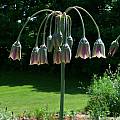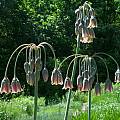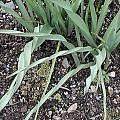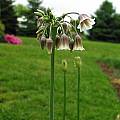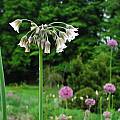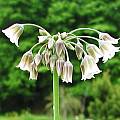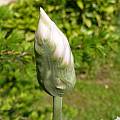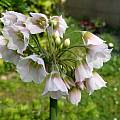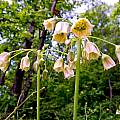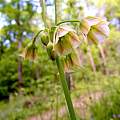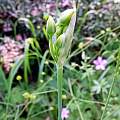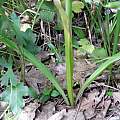Allium siculum Ucria (syn. Nectaroscordum siculum (Ucria) Lindl.) was often confused with a very similar species A. bulgaricum (Janka) Prodan. That species in 2025 is considered a synonym of ssp. dioscoridis. These are intriguing, easy-to-grow plants, well worth cultivating. The large, waxy, bell-shaped flowers are produced in May to early June atop 3' (1 meter) stems, the florets suspended on long drooping pedicels, adding to the charm of the quaintly hued blooms. Here are 3 views of this unusual plant. Notice in the 3rd photo that the foliage is instantly recognizable, being triangular in cross-section and strongly twisting along the length of the ascending leaves, as if sculpted of wrought iron. Photos by Mark McDonough.
Allium siculum ssp. dioscoridis (Sm.)K.Richt. (syn. Nectaroscordum meliophilum (Juz.)Stank., syn. Nectaroscordum bulgaricum Janka) from the Saint Petersburg Botanic Garden, said to have originally been from Crimea. The outside of the tepals are dark brownish-olive-rose color with white flared tips, eventually opening into lovely white bells softly tinged olive and dull rose on the outside. Some flowers have 7-8 tepals instead of the normal 6. It is 24" (60 cm) tall in bloom. The first three photos were taken by Mark McDonough, taken May 25, 2003, showing the order of flower development. The last two photos were taken by Alessandro Marinello.
The plant formerly known as Nectaroscordum bulgaricum Janka is native to the Mediterranean and adjacent areas (Romania to Turkey). The Dutch bulb industry has popularized this plant, which has drooping, bell-shaped flowers.The plant enjoys full sun and good watering while growing. It is a late winter/spring grower in Berkeley, CA and flowers late May-June in early summer. Photos from iNaturalist were taken of Allium siculum ssp. dioscoridis by katunchik in Bulgaria in May and shared under a CC BY-NC license.
